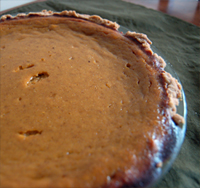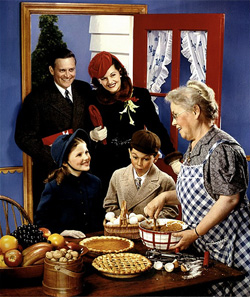In these days of 200-mile locavore meals and freshness trumping shelf life so much of the time, why does canned pumpkin remain so firmly entrenched in our lives? It’s not like we’re just talking about some starchy tuber like the potato. This is the pumpkin, the friendly fruit that makes a dessert arguably more American than apple pie. But when it comes time to put pumpkin in the oven, recipe hockers from Sandra Lee to Saveur open the can.
Obviously, it wasn’t always this way. The pumpkin was used in uncanned form by the Native Americans, who not only ate it, but also wove dry pumpkin strips into mats. When the colonists showed up on the scene, hungry and sick of boats, they incorporated the pumpkin into their cuisine. According to the Cooperative Extension at the University of Illinois, “The origin of pumpkin pie occurred when the colonists sliced off the pumpkin top, removed the seeds, and filled the insides with milk, spices and honey. The pumpkin was then baked in hot ashes.”
Libby’s canned pumpkin — which today holds the largest share of the canned-pumpkin market — hit store shelves in 1929, at a time when many were still canning goods at home. Over the last 80 years, that situation has undergone a drastic reversal: Not only is home canning out of vogue, but in 1994, the USDA stopped recommending or providing instructions for canning your own pumpkin puree. As Dr. Elizabeth L. Andress, a food safety specialist, explained, “Studies conducted at the University of Minnesota in the 1970s indicated that there was too much variation in viscosity among different batches of prepared pumpkin purees to permit calculation of a single processing recommendation.” Basically, the USDA wasn’t confident that it could instruct you how to can pumpkin puree while avoiding botulism.
This variation in the University of Minnesota study also points to one of the main reasons why people use canned pumpkin: It’s not just convenient; it’s reliable. Libby’s has the same smooth consistency, deep-orange color, and sweet taste every time you open a can. People seem to think, though, that this translates to fresh pumpkins being completely unreliable and unwieldy. They aren’t any more so than any other fruit or vegetable. We all pick up a mealy apple now and again, and cooking pumpkin isn’t that different from cooking butternut squash, which shows up in kitchens regularly.
Plus, that variety is one of the greatest benefits of cooking with fresh pumpkin — there are several different types of pumpkins out there, allowing you to pick your favorite. You really shouldn’t cook jack-o-lantern pumpkins — their flesh is stringy and flavorless — but Sugar, Cushaw, and Winter Luxury pumpkins all make good eating. Libby’s uses Dickinson pumpkins, a variety that cross-pollinates with butternut squash. Similar to the Dickinson pumpkin is my favorite pie pumpkin, the Long Island Cheese. It’s tan and somewhat squat like a wheel of cheese, and it has a nice, sweet orange flesh that tastes somewhat lighter than Libby’s canned pumpkin.
In the end, I find that cooking fresh pumpkin is the kitchen equivalent of fighting a tiger with my bare hands: I don’t have to do it, and it’s a little tough and scary, but it makes me feel good in a primal way. Whether or not canned pumpkin is on store shelves. • 19 November 2009
| Pumpkin Puree |
| Preheat your oven to 375 degrees F. With a large, sharp knife, cut your pumpkin open. Scrape out the innards; save the seeds to roast if desired. Cut the pumpkin into quarters, rub them with butter, put them in a pan and cover with foil. Cook the pumpkin until soft, approximately an hour and a half. Remove the pumpkin from the oven and cool, then puree the soft pumpkin flesh in the blender. |
| Pumpkin Pie, Adapted from a recipe in Bon Appetit by Elinor Klivans |
 2 cups pumpkin puree 2 cups pumpkin puree½ cup pure maple syrup (I enjoy a less-sweet pie, but feel free to add another ¼ cup of syrup) ¾ cup heavy cream 3 eggs 2 T butter, melted ½ tsp vanilla extract 1 tsp cinnamon ½ tsp grated fresh ginger ¼ tsp cloves pinch allspice Pie crust of your choosing Heat the oven to 350 degrees; line a pie dish with your crust and cook for 15 minutes. While the crust is cooking, whisk together all filling ingredients. Remove the crust from the oven, pour the filling in, and cook until it sets, approximately an hour. Cool on a wire rack. |




